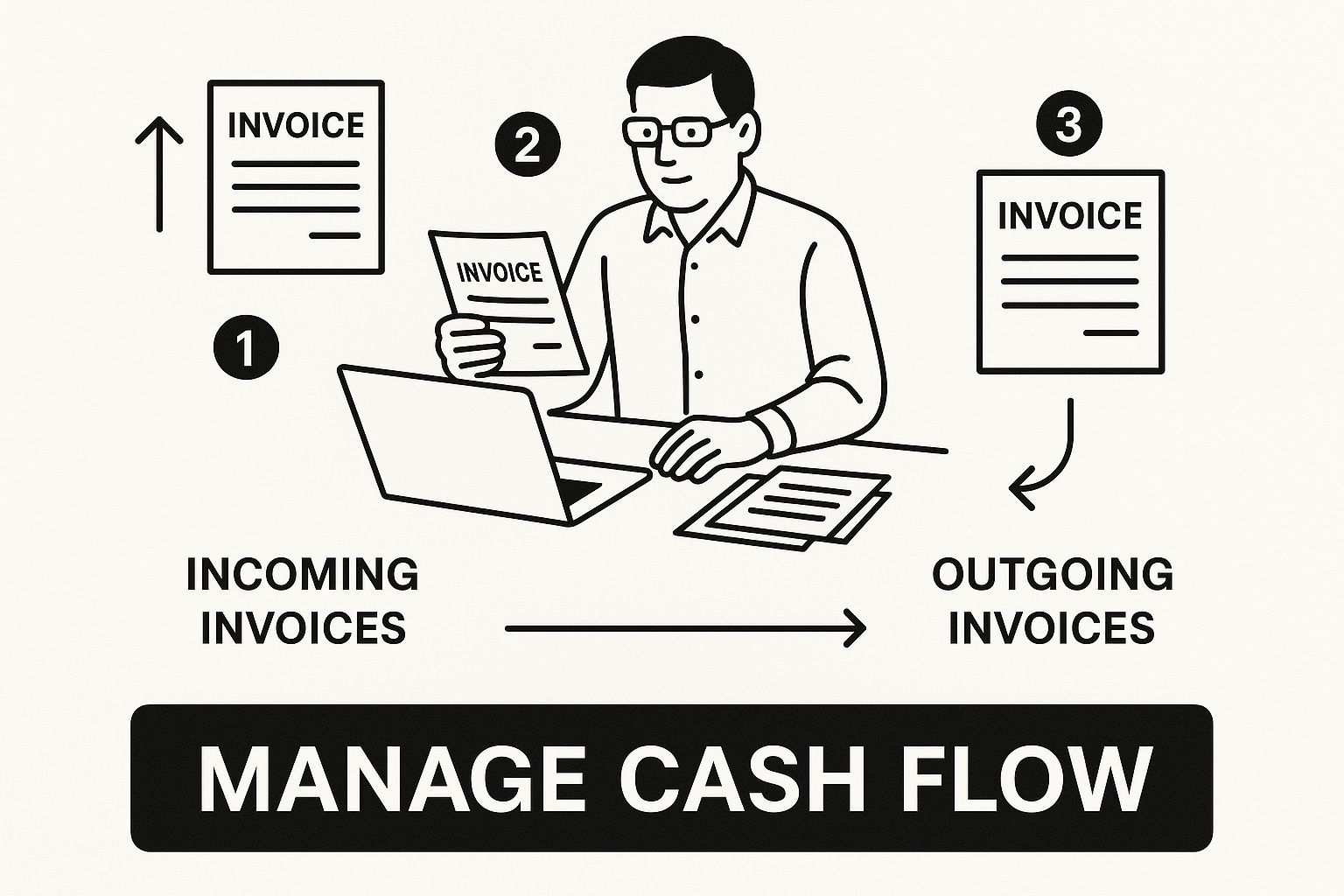Ever had that heart-stopping moment? You look at your sales report, and it’s glowing—a record month! But then you glance at your bank account to make payroll, and it's practically empty. This stressful gap between profit on paper and cash in the bank is a problem all too familiar to business owners.
The good news? You can fix this. A quick win is to start sending invoices the same day you complete work, not at the end of the week or month. This simple change can start improving your small business cash flow immediately.
Struggling with Cash Flow Is More Common Than You Think
If you’re feeling the pressure of tight cash reserves, you’re not alone. This isn't a sign you're failing; it's a rite of passage for countless business owners. The problem usually comes down to a simple, but critical, misunderstanding: profit doesn't pay the bills—cash does. This disconnect is so fundamental that it's one of the biggest reasons businesses don't make it.
In fact, a staggering 82% of failed small businesses cited cash flow problems as a key factor. That’s a massive number, and it drives home just how crucial it is to get a firm grip on your finances. You can explore more insights on these business trends and see for yourself how solid financial management is the bedrock of a long-lasting business.
Your 30-Day Cash Flow Health Check
Let's turn that anxiety into action with a step-by-step check-up. This exercise isn't about complex accounting; it's about getting a fast, honest snapshot of your financial reality from the last 30 days.
Step 1: Gather Your Numbers
Pull up your bank and credit card statements from the last 30 days.
Step 2: Fill Out This Quick Table
Use this simplified table to quickly assess your cash position by comparing your essential inflows and outflows from the past month.
| Financial Item | Last Month's Total ($) | Action Items or Notes |
|---|---|---|
| Cash Inflows | ||
| Client Payments Received | e.g., Follow up on overdue invoices | |
| Other Income (Loans, etc.) | e.g., Note any one-time cash injections | |
| Total Cash In | ||
| Cash Outflows | ||
| Payroll & Contractor Fees | e.g., Review contractor hours | |
| Rent & Utilities | e.g., Check for any unusual spikes | |
| Software & Subscriptions | e.g., Cancel unused services | |
| Inventory & Supplies | e.g., Are we overstocked? | |
| Marketing & Ad Spend | e.g., Check ROI on recent campaigns | |
| Total Cash Out | ||
| Net Cash Flow (In - Out) | Is this positive or negative? |
Step 3: Identify Your Action Items
The real value is in the "Action Items" column. Did you spend way more on supplies than you thought? Are a few clients dragging their feet on payments? These notes become your immediate to-do list for improving your small business cash flow. For example, if you see a high "Software & Subscriptions" cost, your action item is to review and cancel any you don't use.

This simple analysis gives you immediate clarity and a clear path forward. The next step is to put the right tools to work for you. Start a free Growlio account and see how its Finance Hub can automate tracking, make invoicing easier, and give you a real-time dashboard of your financial health.
Why Cash is King (and Profit is Not)
Ever had one of those heart-stopping moments? You’re looking at a P&L statement that shows a fantastic, profitable month, but when you glance at your bank balance to make payroll, it’s practically empty. It’s a jarring, all-too-common feeling for entrepreneurs.
This is where a crucial mindset shift needs to happen. The simplest way I can put it is this: profit is a score, but cash is the fuel.
Profit tells you if your business model is working over the long haul. It's a theoretical number. Cash, on the other hand, is the very real, very immediate lifeblood that keeps the lights on, pays your people, and covers your inventory. A business can look profitable on paper for months and still go under simply because it ran out of actual money. It happens more than you’d think.
The Three Flavors of Cash Flow
To get a real handle on where your money is going, you have to understand that not all cash flow is the same. Accountants break it down into three main categories, and doing so helps you pinpoint exactly which parts of your business are making money and which are eating it.
Operating Cash Flow: This is the big one. It’s the cash that comes directly from your core business—selling your product or service—minus the cash you spend to make it happen (like salaries, supplies, or marketing). A healthy, positive operating cash flow is the clearest sign that your fundamental business is sustainable.
Investing Cash Flow: This tracks the money you use to grow the business for the long term. Think of purchasing major assets like new equipment, a company vehicle, or even property. It also includes any cash you get from selling those kinds of assets.
Financing Cash Flow: This is all about the cash moving between your company and its owners or lenders. It includes money from investors, cash from a new loan, or the money you pay out to service your debt.
Looking at your cash flow through these three lenses stops you from making a classic mistake: confusing a one-time loan (a financing inflow) with strong sales (an operating inflow).
Mini Case Study: The Freelance Designer's Cash Crunch
Let's look at "Design by Dana," a solo graphic design studio. Last quarter, Dana sent an invoice for a $20,000 branding project. On paper, she was incredibly profitable. The problem? Her client’s payment terms are Net 60, meaning she won't actually see that cash for two whole months.
In the meantime, real money was flying out the door:
- $2,500 for a powerful new computer (an investing outflow).
- $1,000 for a payment on her business line of credit (a financing outflow).
- $3,000 for software subscriptions and her virtual assistant (operating outflows).
Even though she was "profitable," Dana's bank account was quickly draining. Her cash flow crunch wasn't because of poor sales; it was a simple timing mismatch between when she had to pay her bills and when she got paid. This is exactly the kind of stressful situation that proactive cash flow management helps you avoid.
Grasping this difference between earning revenue and actually receiving the cash is the single most important lesson in business finance. Now that you understand the "why," it's time to learn "how" to track it all.
Ready to stop guessing and start knowing exactly where your cash is? The first step is getting all your financial data in one place. Start a free growlio account and connect your accounts to its Finance Hub for a real-time, crystal-clear view of your cash position.
How to Build and Understand Your Cash Flow Statement
Are you tired of staring at spreadsheets, trying to piece together your financial story long after the money has come and gone? It’s a common frustration. You know you should have a grip on your finances, but creating a cash flow statement feels like a job for a seasoned accountant.
Here's the good news: you don't need a CPA license to understand where your money is going. You just need a better way to look at it.
A cash flow statement is simply the story of how cash moves through your business over a set period—like a month or a quarter. While you could build one by hand, modern tools have thankfully made that process obsolete. In growlio, this statement is generated automatically once you connect your bank accounts, giving you a real-time view without the manual work.

Think of it like this: your business has cash flowing in from customers and cash flowing out to pay for expenses. A cash flow statement tracks that journey, giving you a real-world picture of your financial health that a simple profit and loss statement can't.
A Step-by-Step Guide to Your Cash Flow Statement
Building your statement follows a logical path. For most small businesses, this means starting with your net income and then making a few key adjustments to see how much cash you actually have.
Start with Net Income: This is the bottom-line number from your income statement. It’s a great starting point, but as we’ve established, profit isn't the same as cash in the bank.
Add Back Non-Cash Expenses: Next, you'll add back any expenses that reduced your profit on paper but didn't actually involve cash leaving your account. The classic example is depreciation. Your equipment gets older and loses value, which is an expense for tax purposes, but you didn't write a check for it this month.
Adjust for Changes in Working Capital: This is where the real clarity comes from. It’s all about timing. You need to account for the gap between when you earn revenue and when you collect the cash. This includes looking at:
- Accounts Receivable: Did your customers owe you more at the end of the period than at the beginning? If so, you'll subtract that increase. It’s profit you've earned but haven’t been paid yet.
- Accounts Payable: Did you owe your suppliers more money? You'll add this increase back. It’s cash you still have, even though you’ve incurred the expense.
- Inventory: If you spent cash to stock up on more inventory than you sold, that cash is gone. You’ll subtract that increase from your cash total.
Mini Case Study: A Creative Agency Finds Clarity
Let me give you a real-world example. A small branding agency was pulling its hair out. Their P&L statement showed a healthy $25,000 net income for the quarter, but the owner was constantly worried about having enough cash to make payroll.
By creating a cash flow statement (which took minutes using growlio), they discovered the problem. A big new client came with Net-60 payment terms, causing their accounts receivable to jump by $30,000. That profit was stuck in unpaid invoices. After all the adjustments, their actual cash flow from operations was a shocking negative $5,000.
This single insight was a game-changer. They immediately updated their invoicing process, offering a small 2% discount for early payment to get cash in the door faster.
Pro Tip: A Quick Health Check
Once your statement is ready, you can calculate a couple of key ratios to see how you're doing at a glance.
- Current Ratio (Current Assets / Current Liabilities): This shows if you can cover your short-term bills. A ratio above 1.5 is generally a good sign.
- Cash Flow Margin (Cash Flow from Operations / Revenue): This tells you how much actual cash you generate for every dollar in sales. The higher the percentage, the more efficient your business is.
Getting this level of financial control is more important than ever. The global small business market is projected to nearly double to $4.985 trillion by 2032, and a big part of that growth is driven by businesses that manage their finances effectively.
Managing cash also means understanding all the little things that chip away at it, like payment processing fees. If you're curious how much you're really paying on card transactions, our simple Stripe fee calculator can show you.
Ultimately, you have to move from just thinking about it to actually doing it. It’s time to stop guessing and start knowing exactly where your business stands.
Forecasting Your Cash Flow for Future Success
Does managing your business finances feel like you're driving while only looking in the rearview mirror? It’s a common trap—you’re constantly reacting to financial surprises after they’ve already hit. Forecasting completely flips that script. It’s about trading that reactive stress for a proactive strategy, giving you a reliable roadmap for what’s coming down the pike.
This isn’t about gazing into some murky crystal ball. It’s about creating an educated, data-backed guess of your future small business cash flow. A good forecast lets you spot potential cash crunches—or even surprise surpluses—weeks or months in advance. Here’s a step-by-step guide to doing it.
Step-by-Step: The 13-Week Cash Flow Forecast
Think of this as your financial early-warning system. It's a surprisingly simple yet powerful tool that estimates the literal cash moving in and out of your bank account. Here’s how to build a basic version.
1. Project Your Cash Inflows
First, get a handle on all the cash you genuinely expect to receive. This isn’t about your total sales figures; it’s about when the money actually lands in your account.
- Sales Forecasts: Dig into your past sales data and look at your current pipeline. What deals do you realistically expect to close each week?
- Customer Payment Patterns: How quickly do your clients really pay? Your invoices might say Net 30, but if experience shows most customers take 45 days, use that more honest timeline.
- Other Income: Don’t forget to include any other expected cash injections, like funds from a loan or the sale of an old piece of equipment.
2. Project Your Cash Outflows
Next, map out all the cash you anticipate spending. Be brutally honest here—it’s always better to overestimate expenses than to get caught with an empty wallet.
- Fixed Costs: These are your predictable, regular expenses like rent, payroll, and software subscriptions. They're usually the easiest to plot out.
- Variable Expenses: This bucket includes costs that change with your business activity, like buying more inventory, paying for shipping, or hiring contractors for a big project.
3. Analyze the Results By adding up your weekly inflows and subtracting the outflows, you'll see a running cash balance. This simple exercise will immediately highlight which weeks might be tight and which ones look healthy.
Mini Case Study: How a Bakery Avoided a Crisis
Sarah runs a popular local bakery. On paper, her sales were booming, but she decided to build a 13-week cash flow forecast. It was a good thing she did.
Looking ahead, she spotted a perfect storm brewing three months out. A large, one-time payment for a new oven was due the very same week she had to make two hefty quarterly tax payments. To make matters worse, this was all scheduled to happen right after her slowest sales month of the year.
Her forecast showed she’d be $15,000 short that week. Instead of panicking when the bills came due, Sarah acted immediately. She took her clear, simple forecast to her bank, easily explained the upcoming (and temporary) shortfall, and secured a small line of credit well in advance. When the cash crunch week arrived, she used the credit line to sail through, paying it back the very next month when sales picked up.
Forecasting turned what could have been a business-threatening crisis into a manageable, non-event.
Pro Tip Box: Advanced Scenario Planning
Once you get the hang of basic forecasting, start playing 'what-if.' In growlio, you can use the forecasting tool to instantly model different scenarios. What happens if your biggest client pays 30 days late? What if a key supplier jacks up prices by 15%? Stress-testing your forecast like this builds incredible financial resilience and gets you ready for bumps in the road before you even hit them.
Of course, manually building and updating these spreadsheets can be a real time-sink. This is where modern tools can be a game-changer. For instance, Growlio’s Finance Hub connects to your accounts and uses your own historical data to create more accurate projections automatically. It lets you run those ‘what-if’ scenarios in seconds, giving you the power of a financial analyst without the headache.
Forecasting is the bridge between just surviving and truly thriving. It gives you the control and confidence to make bolder decisions, invest in growth, and navigate the future without constantly looking over your shoulder.
Proven Strategies to Improve Your Business Liquidity

Does it feel like you’re constantly waiting for money to land in your account while bills keep piling up? That stressful gap between finishing work and getting paid is a huge bottleneck for your small business cash flow.
Improving your liquidity isn't about finding one magic bullet. It’s about making a series of small, consistent adjustments to how money flows into and out of your business. This is actionable, step-by-step guidance—no fluff.
Step 1: Accelerate Your Cash Inflows
The faster you can turn your hard work into actual cash in the bank, the healthier your business will be. The name of the game is systematically shrinking the time it takes to get paid.
- Invoice Immediately and Clearly: Don’t wait. The moment a project is done or a product is delivered, get that invoice out the door. In growlio, you can create and send professional invoices in seconds. Make sure the due date, amount, and payment instructions are impossible to miss.
- Offer Early Payment Discounts: A small discount, like 2% off if the bill is paid within 10 days (often called "2/10, net 30"), can be a surprisingly powerful nudge for clients. Sure, you sacrifice a tiny slice of profit, but getting that cash weeks earlier is often worth far more.
- Accept Diverse Payment Methods: If you're only letting clients pay by check, you're slowing yourself down. By accepting credit cards and online transfers via platforms like Stripe, you make it incredibly easy for them to pay you instantly. You can easily add a "Pay Now" button to your growlio invoices.
Step 2: Control Your Cash Outflows
Just as important as getting money in the door faster is being smart about how it goes out. Every dollar you can keep from leaving your account is another dollar you can use to operate and grow.
- Negotiate Better Supplier Terms: Don't be shy about asking your regular suppliers for better terms. Even extending your payment window from Net 30 to Net 45 gives you an extra two weeks to hold onto your cash.
- Review Recurring Expenses Meticulously: Go through your bank statements and question every recurring charge—especially software subscriptions. Are you really using all of them? A tool like growlio consolidates many functions, which might let you cancel several other subscriptions.
- Lease Equipment Instead of Buying: For big-ticket items like computers or specialized machinery, leasing can be a cash-flow-friendly move. It turns a massive one-time expense into smaller, predictable monthly payments.
Mini Case Study: How an Agency Slashed Payment Times
A small marketing agency was consistently waiting 45-60 days to get paid on their Net 30 invoices. The lag was killing their cash flow. They made two simple changes using growlio:
- Automated Reminders: They set up automated reminders for invoices that were approaching their due date and again once they became overdue.
- One-Click Payments: They added a big, bold "Pay Now" button to every invoice that linked directly to an online payment portal.
The result? Within a single quarter, their average collection time dropped from 48 days to just 19. This single process shift dramatically improved their cash position, a perfect example of what you can find by exploring business process improvement methods.
Pro Tip Box: Advanced Inflow Tactics
For more advanced control, think about using retainers or requiring deposits for large projects. A monthly retainer provides predictable, recurring revenue that smooths out those cash flow bumps. For big one-off jobs, asking for a 30-50% upfront deposit ensures you have the cash on hand to cover initial costs without floating the expense yourself. You can easily set up recurring invoices for retainers in growlio.
For a deeper dive into actionable advice, you can also explore these effective strategies to improve cash flow. Mastering these inflows and outflows is the key to building a more resilient business.
Taking Control: From Surviving to Thriving
Does it feel like you’re constantly playing defense with your finances, always reacting to surprises instead of planning your next big move? That’s a common—and incredibly frustrating—place for entrepreneurs to be. You're not alone if you feel stuck in survival mode.
The good news is that you now have the tools to change that. This guide has laid out the roadmap: you know why cash is king, how to read your financial statements, and the power of looking ahead with forecasting. It's this proactive approach to small business cash flow that separates the businesses that just scrape by from the ones that confidently grow.
Turning Knowledge into Action
Ultimately, the goal isn't just to keep the lights on; it's to build a business that truly thrives. Mastering your company's financial health is the foundation for everything else, and a comprehensive guide to cash flow management for small business success can offer even deeper insights.
This journey is about more than just numbers on a spreadsheet. It's about taking control of the very activities that bring money into your business.
When you have that kind of control over your cash, it changes everything. It even makes it easier to manage client expectations with confidence right from the start.
Your Clear Next Step
Here's the key takeaway: you are in the driver's seat. The next step is to take these ideas off the page and put them into practice. Don't let this be just another article you read—make it the one that prompts real change.
Start a free growlio account today and see how our Finance Hub makes it all easier. From automated statements to AI-powered forecasting, we give you the tools to trade financial stress for confident control.
Common Cash Flow Questions Answered
Even with a solid grasp of the basics, cash flow can throw some curveballs. Let's tackle a few of the most common questions that pop up for small business owners.
What’s the Fastest Way to Get More Cash in the Door?
Almost without fail, the quickest way to boost your cash flow is to get paid faster. This means tightening up your accounts receivable.
Don't wait until the end of the month to send invoices. Bill your clients the second the work is done or the product is delivered. You can also give them a nudge to pay early by offering a small discount—something like 2% off if they pay within 10 days. It's a small price for you to pay to get that cash in your bank account now instead of weeks from now.
How Often Should I Be Looking at My Cash Flow?
For most small businesses, a weekly check-in is the perfect rhythm. It’s frequent enough to catch problems before they snowball but not so often that it feels like a chore. If you can't manage weekly, a monthly review is the bare minimum. Using a dashboard like the one in growlio gives you a real-time view, so you can check in daily without any extra work.
Can My Business Be Losing Money but Still Have Positive Cash Flow?
Absolutely, and it’s a trap that catches a lot of entrepreneurs off guard. This usually happens in the short term.
Imagine you just landed a big business loan. That cash infusion from financing activities will make your bank balance look fantastic, creating positive cash flow for that period. But the loan itself doesn't mean your actual business operations are profitable.
Think of it as a sugar rush—it feels good for a moment, but it's not sustainable. A truly healthy business needs to be profitable and generate positive cash flow from its core operations over the long haul.
Ready to stop guessing and start taking control? The best way forward is to see your own numbers laid out clearly. growlio gives you all the tools you need in one place—from invoicing to real-time financial reports—so you can manage your cash flow with total confidence. Start your free growlio account and see what a difference it makes.
